GamePro wasn’t the first game magazine I read, but it was the first one I outgrew. I wasn’t alone in this. GamePro pitched squarely to the younger crowd with its goofy puns, colorful layouts, and tendency to say nice things about any game that did not immediately and irreparably blind the player. Even today, the original early ‘90s GamePro inspiries jokes about those softballed ProTips and a rating system of excited faces.
Well, I’ve changed my mind on GamePro. It’s now a fascinating document of its era. For one thing, I enjoy how sure-footed a magazine it is. Unlike the other mags of the early 1990s, GamePro knew exactly what it wanted to be, from its corny wordplay to its neon splashes, and its kid-focused editorial voice is nothing if not consistent. Video games were in a juvenile but charming place back then, and GamePro captures that better than any other publication.
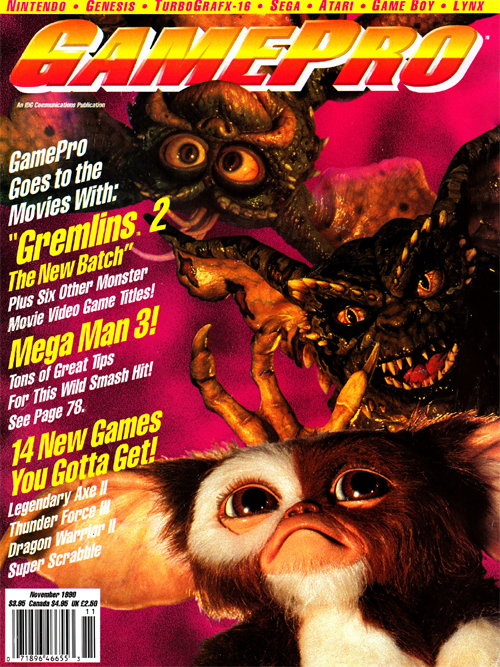
The first GamePro I ever read was the November 1990 issue. I initially wanted it for the Mega Man 3 preview, but a better reason emerged: my mother didn’t like it. She didn’t care for the Gremlins on the cover, but she couldn’t come up with a specific argument as to why I couldn’t get it. Gizmo and Daffy weren’t really objectionable; they were just hideous. And I was just old enough to want anything my parents didn’t.
Yet there’s nothing remotely threatening in this GamePro. Even the Gremlins 2 coverage is part of a broad feature on movie-based games, including Dirty Harry, Days of Thunder, and Total Recall. Most of these games are terrible, and GamePro is diplomatic as ever, telling us that LJN’s dreadful Back to the Future II and III “doesn’t seem like much at first.” There’s a reason Sunsoft’s well-made Gremlins 2 got the cover.
But what really jumped out from this issue of GamePro? The variety. I’d read only Nintendo Power as far as game mags went, and now I had an illuminating look at the Sega Genesis and TurboGrafx-16, which in turn gave me more reasons to bug my parents for new games. Maybe that had bothered my mother more than Gremlins.
Here are some highlights from my crash course in subversion.
1. A GAME GENIE DEBATE
GamePro’s letters section rarely reveled in controversy, but this issue dedicates a page to reader opinions on the Game Genie. By this point Nintendo had sued Galoob to block U.S. sales of the Genie, a pass-through device that let players exploit Nintendo Entertainment System games well beyond what run-of-the-mill cheat codes allowed.
Nintendo claimed this infringed on copyrights, but was really another attempt to preserve a draconian grip on the NES market. Nintendo didn’t even like the idea of NES owners renting games or buying them used, and damned if they were going to let some upstart cheating device further loosen their clutches.
Nintendo couldn’t say this outright, of course, so the public argument against the Game Genie held that cheating made a game less enjoyable and a player less likely to buy it. The majority of NES owners weren’t having any of that.
The letters strike a repeating timbre: cheating doesn’t make a game boring, and anyone who dislikes the Game Genie doesn’t have to buy it. It’s all very sensible, and the general reaction may explain why Nintendo was never extremely vocal in its war with the Game Genie. Galoob, on the other hand, took out ads directly referencing the lawsuit.
I take issue only with the recurring reader contention that beating a game often made you want to buy it. A bunch of kids, myself included, collected NES games like bulky plastic baseball cards, but I knew plenty of other children who were done with games once they’d dusted off the last boss. The Game Genie let them finish tepid but ridiculously hard games and then never again have to think about Dynowarz or The Adventures of Bayou Billy.
Things worked out in the end. Nintendo’s suit fell through, and the Game Genie prospered throughout the early 1990s. Today we can appreciate it for what it always was: an inexpensive adapter for Japanese cartridges.
2. THE TURBOGRAFX-16 VOMITS GAMES IN FEAR
The 16-bit systems wars had barely begun in 1990, and already the TurboGrafx-16 was a little desperate. The Super NES hadn’t even launched in America, but the Sega Genesis and the vanilla NES were apparently stiff competition for NEC and Hudson’s confusingly named little console. I submit this two-pager as evidence.
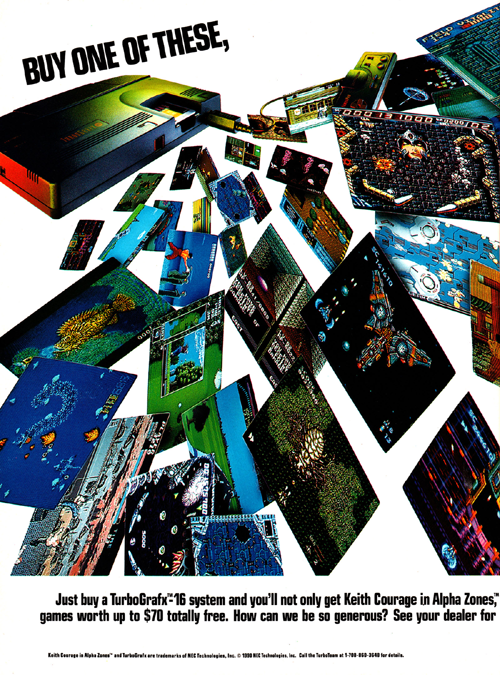
The TurboGrafx-16 made some early wrong turns, one of them a pack-in game called Keith Courage in Alpha Zones. It isn’t completely terrible, but it was uninspiring at best when it came to selling a game console. Customers needed better bait, and it was too late to dig Keith Courage out of every system’s box and replace it with R-Type or The Legendary Axe. This demanded drastic measures.
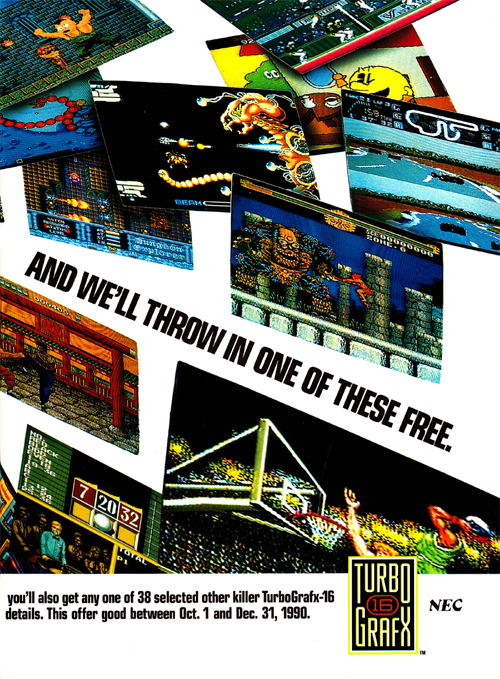
Well, it’s drastic by the standards of game systems. The entire TurboGrafx library was less than a year old, and offering an extra title for free was a bold move even if the selection wasn’t huge (note that many games appear twice in this layout). It’s also true that very little of the catalog impressed like Sega and Nintendo’s standouts, but any kid who wanted a TurboGrafx-16 could land a decent game with Blazing Lazers, Dungeon Explorer, or, if they were uncommonly prescient, Devil’s Crush. It’ll be worth good money in 25 years, kids.
3. RAD GRAVITY GUEST STARS
Nintendo Power had Nester. Sega Visions had Niles Nemo. GamePro had…well, GamePro. And GamePro didn’t skimp on their mascot at first. Each issue dedicated a few pages to Francis Mao and Michael Kavish’s GamePro comic, which sent a displaced superhero to one video-game world after another, Normally these realms represented popular titles like Bonk’s Adventure or Michael Jackson’s Moonwalker, but the November 1990 issue chose The Adventures of Rad Gravity for its centerpiece.
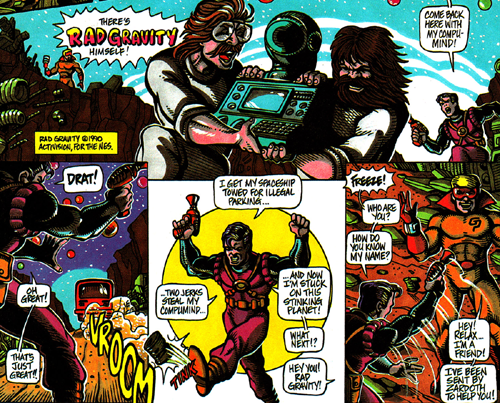
It’s not as though Rad Gravity was a bad NES game. It was just an obscure one by late 1990, and I’d like to know the brainstorming sessions or backroom agreements that led to the GamePro comic hyping it instead of Castlevania III or ESWAT. I also appreciate the gleeful expressions of the two lowlifes stealing Rad’s compu-mind. Usually you’d have to turn to The Fabulous Furry Freak Brothers or a cautionary Jack Chick comic to see such easily elated scumbags.
4. NATSUME RISES
This issue was many a reader’s introduction to Natsume. Today they’re known for the Harvest Moon series and that amazing Wild Guns revamp, but in 1990 they’d only begun releasing their own titles in America. GamePro notes this in a big review of Shadow of the Ninja, describing Natsume as a newcomer “whose programming prowess appears in a bunch of other carts, such as Contra and Abadox.” And that’s actually true. Natsume didn’t secretly make the original Contra for Konami, but one of the game’s composers, Kiyohiro Sada, later moved to Natsume. A deep cut there, GamePro.
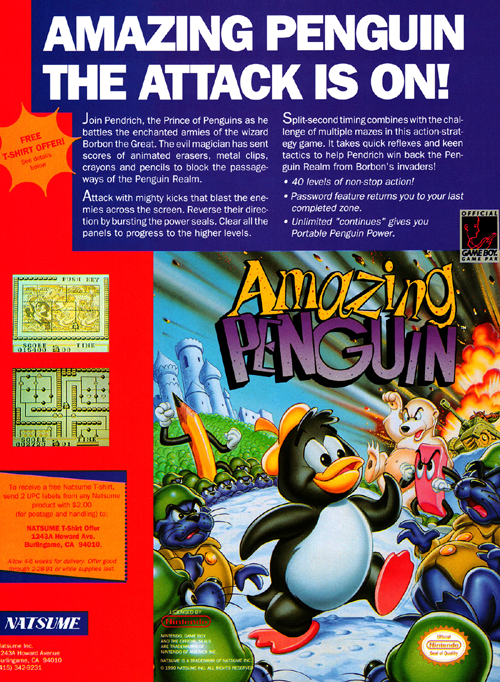
Natsume paid back GamePro with nice big ads for Amazing Penguin and Shadow of the Ninja, both of which present memorable cover art (I especially like the angry eraser) and a special offer: you could mail away for a t-shirt, OR you could beat a Natsume game and get a shirt for free. Given the company’s catalog, Amazing Penguin was the easier game to finish, but perhaps some kids had Game Genies, freshly imported from Canada, to help with Shadow of the Ninja.
Images of Natsume’s Game Master shirts survive online, and the company’s even selling one on eBay right now. I’m always glad to see seemingly irrelevant merchandise brought to light. Many trinkets referenced in these old magazines seem lost to the ages, and when they do appear they’re bizarrely expensive. If someone ever finds Dino Land figures from Telenet’s arcade in Hawaii, you can expect a ferocious bidding war.
5. MEGA MAN MEETS BRUCE
I don’t envy the writers who had to translate Japanese game terms in the early 1990s. They were flying blind much of the time, making due with katakana titles that gave no indication of their English equivalents. And heaven help them if it was a made-up word in the first place. It’s no surprise that this issue of GamePro has a Super Famicom release schedule that turns Gdleen into “Gadulin” and Actraiser into “Laser.”
Even a familiar series like Mega Man had its pitfalls. The Japanese versions used different names for several characters, preserving the musical references by calling Mega Man “Rockman.” When Mega Man 3 appeared, Capcom apparently didn’t tell GamePro that Blues, Mega Man’s Racer X-esque brother, would be known as Proto Man in the West. And guess what proper name Blues resembles in katakana?

Yep, Mega Man is beset by the ominous BRUCE in his latest game. True, the editor could’ve dodged this by leaving out the name entirely (Proto Man’s not even identified until midway through the game), but it’s a minor gaffe. It’s enough that the magazine didn’t tell kids to look forward to other Capcom games like Meaty Final Fate and Suit Free Fighter II.
6. UNLIKELY COMBO ADS!
You know what I like about these old game magazines? Combination ads. A lot of smaller companies of the Nintendo heyday couldn’t afford to buy full-page promotions for every game they released, so games had to share space even when they had little in common.
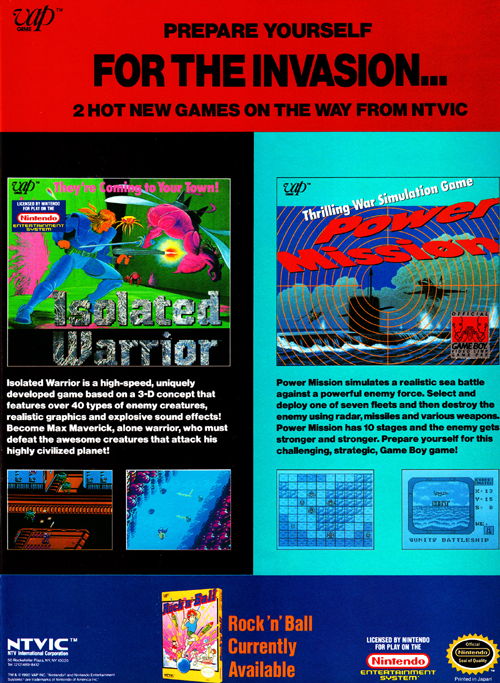
Check out this simple spot from NTVIC and VAP, the latter of which should be a familiar name to anyone who’s sat through too many humdrum ‘90s anime OVAs. They’re pitching both Isolated Warrior for the NES and Power Mission for the Game Boy, with a little stinger for those of you wondering if Rock ‘N Ball is currently available. A canny marketer might’ve given the bulk of the ad to Isolated Warrior, an impressive action game that lends itself to big screenshots, but they didn’t play favorites at VAP Games.

Check out this simple spot from NTVIC and VAP, the latter of which should be a familiar name to anyone who’s sat through too many humdrum ‘90s anime OVAs. They’re pitching both Isolated Warrior for the NES and Power Mission for the Game Boy, with a little stinger for those of you wondering if Rock ‘N Ball is currently available. A canny marketer might’ve given the bulk of the ad to Isolated Warrior, an impressive action game that lends itself to big screenshots, but they didn’t play favorites at VAP Games.
An even better example comes from Toho, which decided that Godzilla, among the most recognizable of all movie monsters, should play second fiddle to something called Circus Caper. A mundane little side-scroller, Circus Caper is notable only for being an extensive re-skin of an older Famicom game based on Tadashi Sato’s The Burning Wild Man manga series. Instead of the original game’s tale of a teenage karate hermit, Toho gave American audiences a kid rescuing his sister from a vaguely evil circus. You’d need Godzilla to sell that.
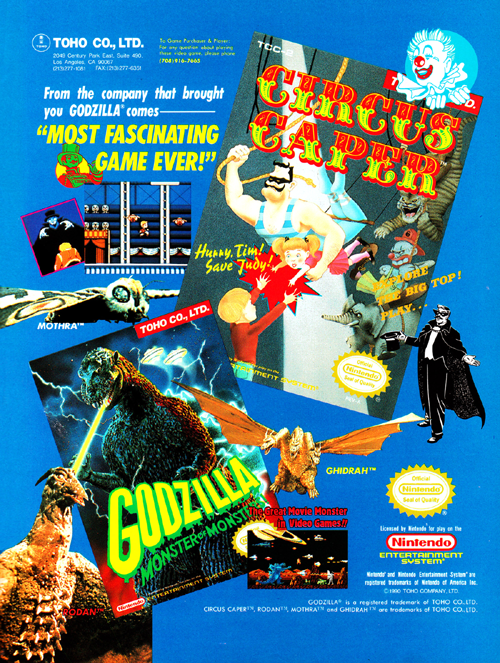
Toho tries to liven up Circus Caper with a quote about it being the “most fascinating game ever,” but you’ll note that it isn’t attributed. I’ll need to see a source before I can believe that anyone said that about Circus Caper. Even GamePro had limits.

Not that Toho would leave Godzilla undersold. The next few pages reveal a full ad for the Game Boy Godzilla title, a simple puzzle game where a cute little version of Godzilla punches things with a fist the size of his entire body. Toho’s copy is once again a little strange, pitching the excitement of destroying rocks and the promise of finding his son Manilla. You know what modern Godzilla movies, from Final Wars to that boring Netflix anime, really need? More rocks.
7. ENTER THE TRADING ZONE
A least a dozen different mail order companies advertised in the back pages GamePro, so The Trading Zone had to hook kids with promises of free things that probably weren’t free. A t-shirt and some coupons aren’t really worth a $10 membership fee, and I’d wager that you had to pay shipping for the poster. Or perhaps that poster truly was free, and its resultant costs were the reason The Trading Zone never lasted long enough to become a retail chain like Funcoland.
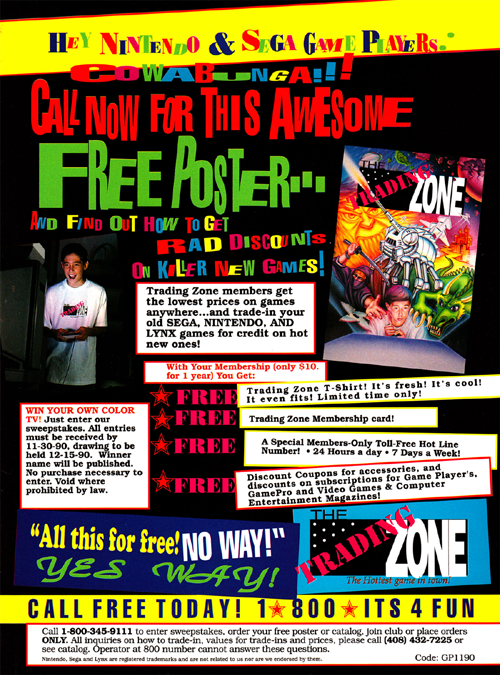
And what about that poster? Well, it has a generic assortment of robots and ninja, and even as an eight-year-old I’d have given it only a month or so on the wall. Of course, this means that some eBayer must be selling the only surviving Trading Zone poster for half a million dollars.


I remember growing out of Gamepro really quickly. I think I thought I was too old for it even as a 12 year old. For a few years though, it was a great magazine with it’s loud layouts and exploding head rating system.
ReplyDeleteI will say one thing – they had the best fighting game coverage. They actually seemed to understand fighters on a competitive level, at least moreso than their competition. I remember buying their SF2 Turbo guide while I was on vacation one year and it was completely eye opening. It had matchup strategies! A tier list! An interview with a top level player! I’ve always loved fighting games and that guide was really my gateway drug into them.
This post is nostalgic for me, I recall loving GamePro circa the early 90’s. I don’t recall it ever seeming childish to me, at the time it seemed like a very ‘cool’ magazine. But then, I would have been just the right age for it’s target market.
ReplyDeleteI do remember feeling they were a little soft in their criticism of truly awful games, but I loved the humour they had and the grading system of overly excited faces rating a game in several categories seemed very advanced to me at the time.
The only other magazine I remember from the time was Nintendo Power which everyone loved, and GamePro allowed a glimpse beyond the Nintendo consoles that I and almost everyone I knew had.
Even the adverts were interesting to me back then, as before the internet they were yet another way to see unknown games.